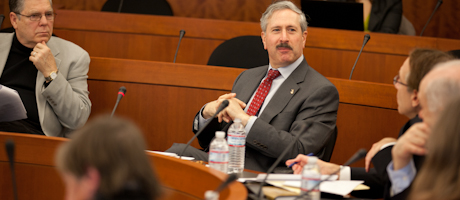At a Faculty Senate meeting Friday, Provost Steven Lerman laid out the process the university will follow in developing a new strategic plan, and GW faculty, students and administrators discussed their strategic plan priorities at a luncheon yesterday. The strategic plan will enumerate the themes and goals that will be the university’s main focus for the coming 10-year period, culminating in GW’s 200th anniversary in 2021.
“The last strategic plan GW had is over a decade old,” Dr. Lerman said. “But that plan is no longer guiding our decisions. No plan lasts forever.”
To start planning for the next decade and beyond, GW must consider the strategic climate it will face, develop a theme for the plan, select three to four broad areas for planning—such as globalization or knowledge creation—and consider the university’s existing strengths, Dr. Lerman said.
“We want to start with themes around which we have some strategic advantage already,” he said. “We want these activities to lead to GW being truly great in the world at the things we choose to do.”
Dr. Lerman described the 10-step process he envisions for developing GW’s strategic plan. The first step—forming an executive planning committee—has already been completed, he said, and the committee includes eight university administrators and faculty members.
Steps two through four—envisioning the strategic climate, developing a theme and selecting key planning areas—will focus on gathering feedback from the university community, through lunch and dinner meetings with faculty and students, briefings with the university Board of Trustees, and submissions via social media. Later steps will include more specific planning of projects, selection of assessment metrics and development of tactics for meeting goals.
Envisioning the strategic climate the university will face in the next decade means taking into account things like the role of technology in changing the way education is conducted, the demand for college education among both traditional-aged students and adult learners, and the importance of interdisciplinary work. And in developing the strategic plan, the university must be selective, especially if it endeavors to see at least preliminary outcomes within three to five years.
“Plans, to be useful, have to make choices,” Dr. Lerman said. “So if a plan tries to be everything to all people, it might as well not be a plan.” Although successful plans need to help an institution focus, the plan itself is cannot be a description of everything that should occur at the university. “There are great program and ideas that the university should embrace and invest in, but that are not necessarily things that should be incorporated into a good plan,” Dr. Lerman said.
Philip Wirtz, a professor of decision sciences and of psychology, recommended that GW decide whether its main objective is to prepare students for jobs, or to become a leading intellectual institution. “Those could carry us in two very different directions,” he said. “If jobs are the driving philosophy of the institution, that necessitates a very different set of emphases than if we say our primary objective is to be known as a thought leader.”
Forrest Maltzman, senior vice provost for academic affairs and planning, said that the strategic plan should help encapsulate why the university is special. “We know what Cal Tech is,” he said. “What is the unique thing about GW? One of them is that we could be known as the nation’s think tank—the place that solves problems and is tapped into Washington.”
At the luncheon Wednesday, small groups of students and faculty members from a diverse set of schools and departments brainstormed key strategic planning topics. Numerous participants mentioned distance learning and the role it could play in GW’s future, especially as the university hits on-campus enrollment caps.
Some meeting participants emphasized the need for distance learning to be high quality and interactive, with a focus on the “high touch” pedagogies of the classroom rather than simply the high-tech methods made possible through new media. But the demand for distance learning will only increase, they agreed.
“I get a request for some kind of distance learning opportunity every other day, from people all over the world,” said Douglas Evans, a professor of prevention and community health in the School of Public Health and Health Services.
GW should also focus on emphasizing the characteristics that make it unique, participants said.
“For us to be competitive with a place that has a much lower cost of living, like faculty in rural Georgia delivering online education, we’ve got to be able to say what’s important about D.C.,” said Amy Cohen, director of the Center for Civic Engagement and Public Service. “To me, that’s scholarship that engages with policy, politics and nonprofit organizations that are here in the District of Columbia.”
Other topics raised as potential foci for GW’s next 10 years included highlighting initiatives to attract minority faculty, ensuring that students have a global perspective and continuing the university’s current emphasis on research at all levels, from undergraduate students to faculty.
And throughout the strategic planning process, the university must focus on the fact that the next decade’s students will need the competencies to flourish in a globally interconnected world.
“The world we live in is vastly more globalized than the world our parents lived in, Dr. Lerman said. “And the world our students will thrive in will be more globalized than it is today.”


